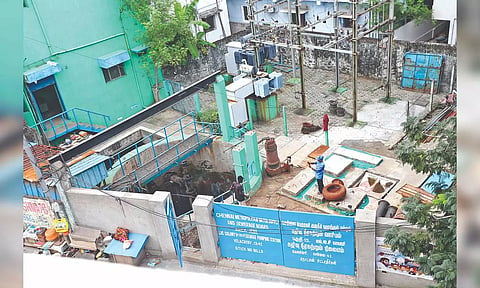

CHENNAI: With the northeast monsoon around the corner, sewage stagnation is one of the most common worry of residents across the city. While the stormwater drainage works are underway across the city, the lack of enough pumping stations is causing multiple inconveniences. Only 300 pumping stations are functional to drain out stagnated waste water on the city roads.
Lack of manpower
Residents of north Chennai witness frequent sewage stagnation due to the lack of manpower in the pumping stations. Local residents lament that the sewage overflow often adds to mosquito menace and emanating stench. The pumping station at Adi Dravidar Colony in Ernavoor has only one staff to maintain the station and at times the station remains closed, residents said adding that they are forced to stay in the area with filthy water stagnated on the street.
“We are tired of complaining to the civic authorities to increase the manpower of the pumping station. Only one person works there for a few hours, just for the namesake. After several complaints to the area engineer, it would take at least 24 hours to solve the issue by the Metro water board,” stated K Venkattaiya, a resident of Erniswarar Nagar in Ernavoor.
We are forced to walk on the sewage and children often fall sick. The number of fever cases surge, especially during the monsoon season. The civic body authorities are lethargic to act on the issue and provide a permanent solution for us, complained the ward 4 residents of Ernavoor.
Toxic gas leakage affects people's health
The pumping station at Perambur faces gas leakage. The issue has not been addressed by the government despite many individuals were affected with lung diseases from toxic gas. Residents urged the authorities to go for a safety check in the pumping station before operating it to pump out sewage in the area. In addition, there is frequent power shutdown in the area and the motors do not function round the clock to pump out the sewage from the residential area.
S Murali, a resident of Perambur said that poisonous gas emerges from the pumping station in the wee hours every day and causes breathing difficulties and headaches for the residents, especially senior citizens and children. A few years ago, my wife suffered serious lung infections due to the gas leaks, alleges an emotional Murali, sharing that his late wife suffered breathing difficulty whenever there was a suspected methane smell emanating from the pumping station.
The need for additional pump stations
Even though the number of residential areas surged in Velachery in recent years, there is only pumping station in the area located at the LIC Colony on Taramani Link Road, which is also one of the oldest stations. Used for multiple areas in Velachery, it does not have sufficient capacity to pump out sewage stagnated. The station covers several areas including Tansi Nagar, Anna Nagar, Dhandeeswaran Nagar, Annai Indira Gandhi Nagar, and Venus Colony.
“Due to blockage in the sewage pipeline of the residential and commercial buildings, the overflowing from manholes has become a perennial problem in the locality. We are tired of drainage stagnation on the streets the situation worsens during the monsoon. We demanded the officials to construct an additional pumping station in the area. But there has been no respite yet,” rued M Balakrishnan, secretary of Tansi Nagar Residents Welfare Association in Velachery.
While one tanker lorry is used to pump out the sewage from seven areas in Velachery, officials claimed that there is no space to construct an additional pumping station in the area. However, there are many vacant plots owned by the government that could have been utilised for the benefit of the people.
The drainage water stagnation on the road becomes a breeding ground for mosquitoes and foul odour is something common during monsoon season. Local residents are unable to stay indoors due to the sewage stagnation that becomes a frequent issue every month. Even though they have raised multiple complaints to the area engineer of the metro water board, there has been no permanent solution from the civic body.
Since 2011, Sholinganallur has been a part of Chennai Corporation, and yet sewage connection in the area has not been taken into consideration. “Lorries that come for sewage waste collection get between Rs 1,200 to Rs 1,500 from each household every week. The families which get a salary of Rs 15,000 are also forced to pay a hefty price for this in addition to other expenses which is a huge amount,” said V Parthiban, a resident in Perungudi.
There is no sewage connection or pumping station facilities in several areas of the city. The local body claimed that pipelines had been installed but without connecting it to the pumping station.
“The civic authorities should ensure that sewage connections in households must be given priority and it must be ensured that the sewage is going to the pumping stations and sewage treatment plants,” said Dayanand Krishnan, a social activist.
‘Will construct more pumping stations’
At present, 325 pumping stations are operational in the city, and the Chennai Metropolitan Water Supply and Sewerage Board (CMWSSB) proposed to construct more than 11 pumping stations, especially in the added areas of the Chennai Corporation. The capacity of the pumping stations depends on the residential buildings in the area.
When contacted, a senior official with the CMWSSB explained that in view of the northeast monsoon, desilting works of sewage lines in 4,500 km across the city have been commenced with 536 vehicles. The motors have been checked at the pumping stations and basic maintenance are carried out. However, there might be a blockage in the sewer line even after desilting which causes overflowing of sewage. In such cases, the sewage would be drained out by using machines during the monsoon season.